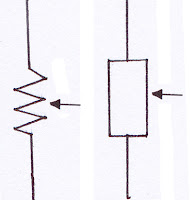Transistors are semiconductor components that are very important in the world of modern electronics. in analog circuits, transistors used in amplifiers. Analog circuits surrounding the loudspeakers, the power source is stable, and the radio signal amplifier. In digital circuits, transistors used as high-speed switches. Some transistors can also be arranged in such a way that serves like logic gate, memory and other components.
A. Types of transistors according to the arrangement of his legs
There are two kinds of transistors based on input current (BJT) and voltage inputs (FET). Following the review two types of transistors:
- BJT (Bipolar Junction Transistor)
Transistors of this type is a transistor that has two diodes, the positive or negative packed, so there are 3 terminals. The third terminal is the emitter (E), Collector (C), Base (B). Changes in electrical current in a small amount on the terminal base can result in changes in electrical currents in large numbers at the collector terminal. This principle underlying the use of transistors as electronic amplifier.
- FET (Field Effect Transistor)
FET transistors are divided into two kinds, namely the junction FET (JFET) and Insulated Gate FET (IGFET) or also known as Metal Oxide Silicon (or semiconductor) FET (MOSFET). In contrast to the IGFET, the JFET gate terminal forming a diode with the channel (semiconductor material between source and drain). In terms of functionality, it makes N_channel JFET the solid state of the vacuum tube, which forms a diode between its grid and cathode.
B. Types of transistors according to the type of pole legs
There are two types of transistors according to the poles, namely:
- NPN (Negativ-Positive-Negativ)
- PNP (Positive-Negativ-Positive)
C. The Symbols Of Transistor
 |
| it is symbol of BJT transistor |
 |
| it is symbol of JFET transistor |
 |
| various forms of transistors |
 |
| it is one of FET Transistor |
 |
| it is one of BJT Transistor |
 |
| it is one of Jengkolan Transistor (name in indonesian) |
E. Testing a Transistor type NPN
- Move the switch to position Ωx100;
connect black wired to Base and red wired on the collectors, the needle must deviate to the right. If red wired moved to the emitter, the needle should be to the right again. Connect the red wired on Base and the black wired on the Collector, the needle should not deviate, and if the black wired moved to emitter, the needle should not deviate too;
- Move the switch on the 1k;
Connect the black wired on Collector and red wired on the Emitter, the needle should be slightly deviated to the right. If reversed, the needle should not deviate. If any of these events did not happen, there is possibility transistor broken.
F. Testing a Transistor Type PNP
- Move the switch to position Ωx100;
Connect the red wired on Base and black wired on the Collector, the needle must deviate to the right. If red wired moved to the Emitter, the needle should be to the right again. Connect the red wired on Base and the black wired on Collector, the needle should not deviate, and if the black wired moved to emitter, the needle should not deviate too;
the steps above can also be used to find out where the foot B / C / E of a transistor;
Navigate to V DC to estimate the transistor material. testing can be performed on the Base and Emitter, if output voltage is 0.2 V, the possibility of germanium material. If the value of output voltage is 0.6 V, the possibility of silicon material.
the steps above can also be used to find out where the foot B / C / E of a transistor;
Navigate to V DC to estimate the transistor material. testing can be performed on the Base and Emitter, if output voltage is 0.2 V, the possibility of germanium material. If the value of output voltage is 0.6 V, the possibility of silicon material.
F. Testing Transistor Type FET
- Move the switch to position Ωx100
Connect the black wired on Source and red wired on the Gate. If the needle deviated, the type of FET is a P channel and if it is not deviated, the FET is the canal N. point switch at x1k or x10k, potensio minimum and resistance should be small. If potensio rotated to the right, the resistance should be infinite. If this event does not occur, there is possibility FET damaged.













